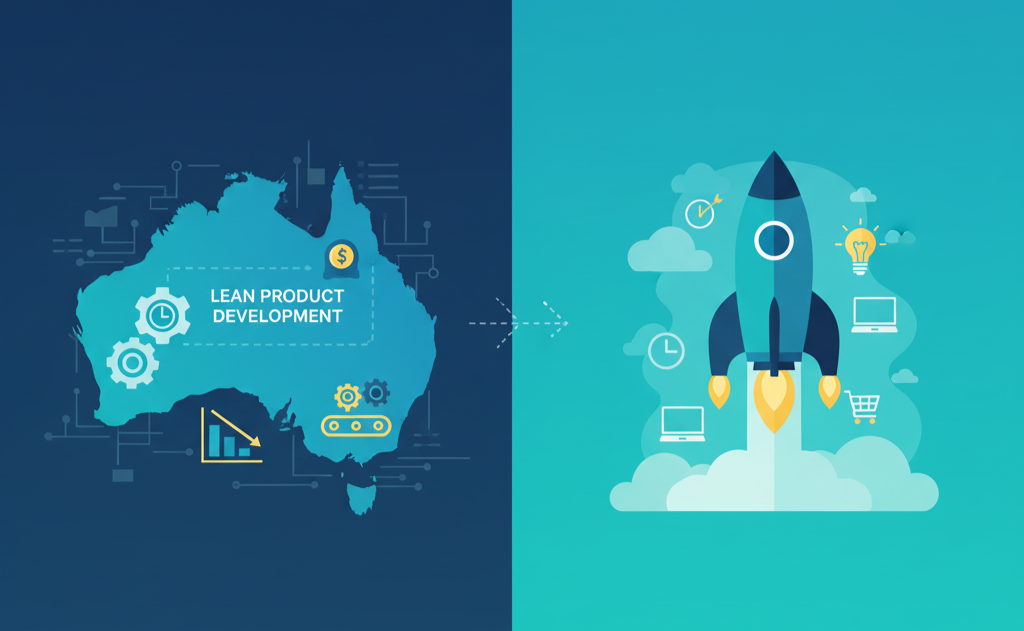
Lean Product Development Australia: Strategies to Reduce Costs and Accelerate Launch
Australia’s Product Development Evolution
Australian businesses face mounting pressure to bring products to market faster while controlling costs. Agile and lean methodologies have already become widely adopted, but by 2025, their importance will only grow. Agile allows teams to rapidly iterate and respond to market changes, while lean principles focus on maximising value and minimising waste in product development.
The Australian market presents unique challenges for product development teams. Geographic isolation, smaller domestic markets, and competition from global players require Australian companies to adopt efficient product development processes that maximize return on investment while minimizing time to market.
Understanding Lean Product Development in the Australian Context
Core Principles Adapted for Australian Markets
Lean product development centers on eliminating waste while creating maximum value for customers. Constantly decreasing costs, no waste, minimum throughput time, maximum capacity, unlimited flexibility, and high customer satisfaction represent the fundamental goals of lean methodology.
In Australia’s competitive landscape, these principles translate to specific advantages. Local companies can leverage lean approaches to compete against larger international firms by moving faster and adapting more quickly to market changes.
The Australian Advantage
Australian product development teams often possess inherent advantages that align well with lean principles. The culture of practical problem-solving, combined with smaller organizational structures, creates natural conditions for rapid iteration and customer feedback integration.
Key Australian Market Characteristics:
| Factor | Impact on Lean Development | Strategic Response |
|---|---|---|
| Smaller domestic market | Faster customer feedback loops | Rapid prototyping cycles |
| Geographic isolation | Focus on digital solutions | Remote collaboration tools |
| Resource constraints | Emphasis on efficiency | Waste elimination focus |
| Innovation culture | Willingness to experiment | Build-measure-learn cycles |
Cost Reduction Strategies Through Lean Implementation
Early Stage Validation Techniques
Traditional product development often involves significant upfront investment before validating market demand. Lean approaches flip this model by prioritizing early validation with minimal investment.
Australian companies can implement validation techniques that reduce financial risk while gathering critical market intelligence. These include customer interviews, prototype testing, and minimum viable product (MVP) launches that require fraction of traditional development budgets.
Resource Optimization Methods
Lean product design is a software development process for creating innovative new products. It enables businesses to get their product to market fast, validate it frequently with users, and continuously respond to feedback. The process involves interweaving lightweight design and user research throughout an agile development process, rather than relying on most of the product design and research to be done up front.
This approach significantly reduces costs by avoiding over-engineering and feature bloat that often plague traditional product development cycles.
Cost Reduction Framework:
- Eliminate Over-Production: Build only what customers actually need
- Reduce Inventory: Minimize work-in-progress and feature backlogs
- Minimize Defects: Implement continuous testing and quality assurance
- Optimize Transportation: Streamline handoffs between development stages
- Eliminate Waiting: Remove bottlenecks in approval and review processes
Technology Investment Optimization
Australian product development teams can leverage local technology capabilities while avoiding expensive international partnerships. Cloud-based development tools, local testing facilities, and regional expertise networks provide cost-effective alternatives to traditional development approaches.
Accelerating Launch Timelines
Rapid Prototyping and Iteration
The key to faster launches lies in shortening feedback cycles. Australian companies excel at this when they embrace iterative development approaches that prioritize learning over perfection.
Product Siddha recently worked with a Melbourne-based fintech startup to implement lean development practices. By focusing on core functionality and iterating based on user feedback, the company reduced their initial launch timeline from 18 months to 8 months while cutting development costs by 35%.
Cross-Functional Team Integration
In 2025, businesses must adopt this methodology to stay competitive. Trends like DevOps, value stream management, and AI-driven agility highlight the growing importance of lean practices. By merging lean and agile, you can streamline processes, reduce costs, and improve customer satisfaction.
Successful Australian product development requires breaking down silos between design, development, marketing, and operations teams. Integrated teams make faster decisions and avoid the delays associated with sequential handoffs.
Market Entry Strategies
Australian companies often benefit from staged market entry approaches that allow for rapid adjustment based on initial market response. Rather than attempting perfect product launches, lean development emphasizes learning-oriented launches that generate market intelligence.
Implementation Framework for Australian Companies
Phase 1: Assessment and Planning
Before implementing lean practices, Australian companies should assess their current product development processes and identify specific waste sources. Common areas include over-specification, excessive documentation, and lengthy approval cycles.
Assessment Areas:
Current development timelines and bottlenecks
- Resource allocation and utilization patterns
- Customer feedback integration processes
- Quality assurance and testing procedures
- Market validation methodologies
Phase 2: Pilot Project Selection
Successful lean implementation often begins with carefully selected pilot projects that demonstrate value without disrupting core business operations. Australian companies should choose projects with clear success metrics and manageable scope.
Phase 3: Team Training and Culture Development
Lean product development requires cultural shifts that emphasize learning, experimentation, and customer focus over internal politics and perfectionism. Australian teams often adapt well to these cultural changes due to existing collaborative work styles.
Tools and Technologies for Australian Teams
Local and Regional Solutions
Australia’s product development ecosystem includes specialized tools and platforms designed for local market conditions. These solutions often provide better value and support than international alternatives.
Recommended Tool Categories:
- Customer feedback collection and analysis platforms
- Rapid prototyping and design tools
- Project management and collaboration software
- Testing and quality assurance systems
- Analytics and measurement platforms
Integration with Global Platforms
While leveraging local solutions, Australian companies must also integrate with global platforms to reach international markets. Lean development approaches facilitate this integration by emphasizing modular, scalable architectures.
Measuring Success in Australian Markets
Key Performance Indicators
Lean product development success requires specific measurements that align with Australian market conditions and business objectives.
Primary Metrics:
- Time to market reduction percentages
- Development cost per feature or functionality
- Customer acquisition cost improvements
- Feature adoption rates and user engagement
- Revenue per development dollar invested
Secondary Metrics:
- Team productivity and satisfaction scores
- Defect rates and quality improvements
- Customer satisfaction and Net Promoter Scores
- Market share gains and competitive positioning
- Innovation pipeline health and diversity
Continuous Improvement Processes
Successful companies are those that can maintain the basic lean philosophy – waste elimination and continuous improvement – while using digital tools to achieve previously unattainable levels of efficiency and sustainability.
Australian companies should implement regular retrospective processes that identify improvement opportunities and adapt lean practices to changing market conditions.
Case Studies from Australian Implementation
Technology Startup Success
A Sydney-based healthtech company partnered with Product Siddha to implement lean development practices for their telemedicine platform. By focusing on core user workflows and eliminating unnecessary features, they achieved a 50% reduction in development time and launched successfully in three Australian states within their original timeline.
Manufacturing Innovation
A Brisbane manufacturing company used lean product development principles to create a new line of sustainable packaging products. The lean approach enabled rapid prototyping with customer partners, resulting in a product that met market needs precisely while maintaining competitive manufacturing costs.
Services Digitization
An Adelaide-based professional services firm applied lean development to create digital tools for their consulting practice. The iterative approach allowed them to refine their offering based on client feedback, ultimately creating a scalable digital product that expanded their market reach significantly.
Future Trends and Considerations
Emerging Technologies Integration
Australian product development teams increasingly incorporate artificial intelligence, machine learning, and automation into their lean processes. These technologies enhance rather than replace human decision-making in product development.
Sustainability and Social Responsibility
Environmental consciousness among Australian consumers drives demand for sustainable product development practices. Lean methodologies naturally align with sustainability goals by eliminating waste and optimizing resource utilization.
Remote and Distributed Development
Australia’s geographic challenges make distributed development teams common. Lean practices facilitate remote collaboration through clear communication protocols, shared objectives, and continuous feedback mechanisms.
Strategic Recommendations
Australian companies seeking to implement lean product development should start with small experiments that demonstrate value before scaling to larger initiatives. The key lies in adapting lean principles to local market conditions while maintaining core waste elimination and customer focus objectives.
Success requires commitment from leadership, investment in team capabilities, and patience during the cultural transition period. Companies that successfully implement lean product development practices position themselves for sustained competitive advantage in both domestic and international markets.
The combination of lean methodologies with Australian business culture creates powerful opportunities for innovation and growth. Organizations that embrace these approaches while remaining true to their market understanding and customer relationships will find themselves well-positioned for success in an increasingly competitive global marketplace.
Ready to implement lean product development practices in your Australian business? Product Siddha specializes in helping Australian companies reduce development costs and accelerate launch timelines through proven lean methodologies. Our local expertise and international experience provide the perfect combination for Australian market success. Contact Product Siddha today to discover how lean product development can transform your innovation capabilities.
